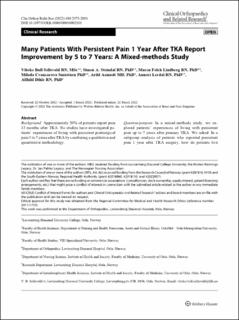| dc.contributor.author | Sellevold, Vibeke Bull | |
| dc.contributor.author | Steindal, Simen Alexander | |
| dc.contributor.author | Lindberg, Maren Falch | |
| dc.contributor.author | Småstuen, Milada Cvancarova | |
| dc.contributor.author | Aamodt, Arild | |
| dc.contributor.author | Lerdal, Anners | |
| dc.contributor.author | Dihle, Alfhild | |
| dc.date.accessioned | 2023-01-23T13:27:02Z | |
| dc.date.available | 2023-01-23T13:27:02Z | |
| dc.date.created | 2022-02-10T08:55:59Z | |
| dc.date.issued | 2022 | |
| dc.identifier.citation | Clinical Orthopaedics and Related Research. 2022, 480 (11), 2075-2088. | en_US |
| dc.identifier.issn | 0009-921X | |
| dc.identifier.uri | https://hdl.handle.net/11250/3045390 | |
| dc.description.abstract | Background
Approximately 20% of patients report pain 12 months after TKA. No studies have investigated patients’ experiences of living with persistent postsurgical pain 5 to 7 years after TKA by combining a qualitative and quantitative methodology. Question/purpose In a mixed-methods study, we explored
patients’ experiences of living with persistent pain up to 7 years after primary TKA. We asked: In a
subgroup analysis of patients who reported persistent pain 1 year after TKA surgery, how do patients live with persistent pain at the 5- to 7-year postoperative timepoint?
Methods
This follow-up study was part of a longitudinal study of pain, symptoms, and health-related quality of life in
patients who underwent TKA for osteoarthritis. The present study targeted a subgroup of patients (22% [45 of 202]) identified in the longitudinal study who reported no improvement inpain interferencewithwalkingat 12months after surgery. Inclusion criteria were: all 31 patients in this subgroup
who attended their 5-year follow-up at the hospital and lived within a 2-hour drive from the hospital. Eight patients declined or were unable to participate due to illness or death. Hence, the final sample consisted of 23 patients (13 women and 10 men). The participants’ mean age at surgery was 666
10 years. There were no differences in sociodemographic baseline data between the 23 included and the 22 excluded participants. A mixed-methods approach was employed, in which the quantitative data were followed up and investigated with qualitative interviews. Instruments used were the Brief
Pain Inventory preoperatively, 12 months, and 5 years after surgery, as well as a semistructured interview guide. The individual interviews were conducted at one timepoint 5 to 7 years postsurgery to capture how pain was experienced at that timepoint. The interviews were audiorecorded, transcribed, and analyzed using qualitative content analysis.Meaning units were identified, condensed, and sorted into subthemes that
were interpreted and abstracted into themes, guided by the research question. With a small sample, the quantitative analysis focused on descriptive statistics and nonparametric statistics when comparing demographics of included and nonincluded patients. In addition, two multivariate mixed models for repeated measures were employed to estimate within‐patient and between‐patient variations as well as to
assess the effect of time on the pain outcomes.
Results
Pain with walking decreased from 12 months to 5years postoperatively (estimated mean score 7 versus 4, difference of means -3 [95% CI -5 to -2]; p < 0.001). Pain with daily activity decreased from 12 months to 5 years postoperatively (estimated mean score 6 versus 3, difference of means -3 [95%CI -4 to -1]; p < 0.001). Pain intensity (average pain) decreased from 12 months to 5 years postoperatively
(estimated mean score 5 versus 4, difference of means -1[95% CI -3 to 0]; p = 0.03). The results are presented as point estimates rounded up to whole numbers. The qualitative data
analysis yielded three themes: persistent limitations afterTKA, regained wellness over time, and complexity in physicalchallenges. Intermittent pain with certain movements
resulted in limitations with some activities in everyday lifeand seemed to persist beyond 5 years. Multiple painful body sites and presence of comorbidities seemed to interfere with
regained wellness over time.
Conclusion
In this subgroup of patients experiencing postsurgicalpersistent pain 12 months after primary TKA, persistent postsurgical pain still limited certain activities for the participants, although pain seemed to be less influential in their everyday lives after 5 years to 7 years. Clinicians may use these findings to inform and guide patients with delayed improvements in pain into more realistic expectations forrecovery, rehabilitation, and strategies for coping with pain and impaired function. However, it is imperative to rule out
other reasons for pain in patients reporting pain 12months and longer after surgery and and to be attentive of possible changes in pain over time. | en_US |
| dc.language.iso | eng | en_US |
| dc.rights | Attribution-NonCommercial-NoDerivatives 4.0 Internasjonal | * |
| dc.rights.uri | http://creativecommons.org/licenses/by-nc-nd/4.0/deed.no | * |
| dc.subject | Smerte | en_US |
| dc.subject | Postoperativ sykepleie | en_US |
| dc.title | Many Patients with Persistent Pain One Year After TKA Report Improvement by 5-7 years: A Mixed Methods Study | en_US |
| dc.title.alternative | Many Patients with Persistent Pain One Year After TKA Report Improvement by 5-7 years: A Mixed Methods Study | en_US |
| dc.type | Peer reviewed | en_US |
| dc.type | Journal article | en_US |
| dc.description.version | publishedVersion | en_US |
| dc.source.pagenumber | 2075-2088 | en_US |
| dc.source.volume | 480 | en_US |
| dc.source.journal | Clinical Orthopaedics and Related Research | en_US |
| dc.source.issue | 11 | en_US |
| dc.identifier.doi | 10.1097/CORR.0000000000002183 | |
| dc.identifier.cristin | 1999781 | |
| dc.relation.project | Helse Sør-Øst RHF: 2022007 | en_US |
| dc.relation.project | Helse Sør-Øst RHF: 2018110 | en_US |
| dc.relation.project | Helse Sør-Øst RHF: 2018060 | en_US |
| dc.relation.project | Norges forskningsråd: 287816 | en_US |
| cristin.ispublished | true | |
| cristin.fulltext | original | |
| cristin.qualitycode | 2 | |

